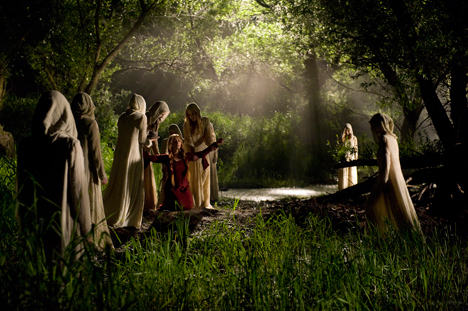
Black Death (2010) wears the influences of The Witchfinder General (1968), The Wicker Man (1973), and Witchhammer (1970) on its sleeve. Part medieval action film, part horror film, Black Death is a film of nihilist vision that embraces its own genre fusions as a means of meditating on the nature of human evil and the empty promise of fate. It’s not original in its concept by any means, but it is an effective exploration of these themes that offers the spectator some uniquely gruesome images.
The film follows a novice monk, Osmund (Eddie Redmayne), who sets out with a knight, Ulric (Sean Bean), and his men to capture a pagan necromancer who has turned an entire village from God and in the process kept the plague at bay. This hero’s journey is a slow descent away from faith. Black Death moves episodically until Ulric and his men reach the village of the necromancer. The build up to this violent conflict between Christian and pagan faiths is an exploration of the commonality of violence in God’s name.
Through the necromancer Langiva (Carice van Houten) the film explores the nature of artifice and illusion at the root of religious power. Langiva is the antithesis of Osmund. Over the course of their interactions, both gentle and sadistic, Osmund is transformed into the monolithic power of vengeful Christian doctrine whose only purpose is to subjugate the masses with fear and violence as opposed to Langiva’s illusions of healing. Both use faith self-servingly, raising the question as to whether faith serves any higher purpose or power at all.
Directed by Christopher Smith, Black Death is a rather sensitive balancing act between violent spectacle and philosophical reflection. That Black Death is executed with the narrative economy of a classic B-movie makes the feat of this balancing act all the more impressive. Smith, who has made a career for himself in the horror movie genre, is equally at home in action scenes as he is staging jump-scares and soft-core torture porn. All the images in Black Death are united by a desaturated color palette and an emphasis on blunt physicality. Black Death is a film that revels in the fragility of human bodies.
The success of Black Death is really down to the central performances of Sean Bean, Carice van Houten, John Lynch and Tim McInnerny who consistently imbue the boldly stylized film with human complexity and nuance. The script gives each of these dynamic performers just enough room to give their characters a little extra dimension. With another filmmaker at the helm Black Death would be just another pretentious horror film littered with performances so superficial that they never escape their archetypal limitations.
